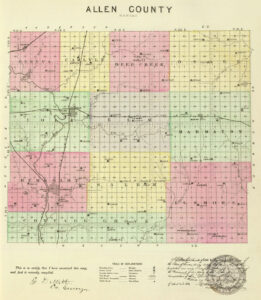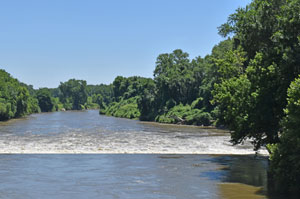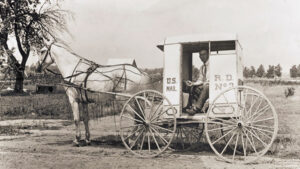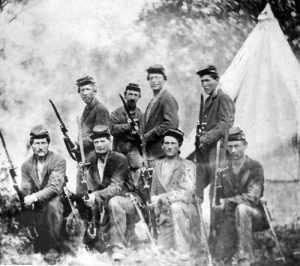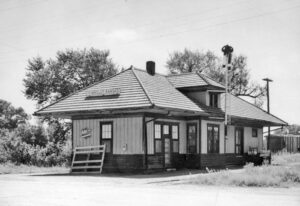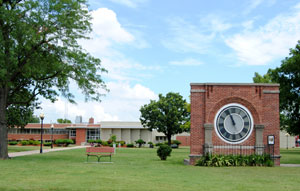Towns & Places:
Gas
Humboldt
Iola – County Seat
La Harpe
Moran
Allen County, Kansas, located in the southeast part of the state, was one of the 36 counties established by the first territorial legislature in 1855. It was named in honor of William Allen, a United States senator from Ohio. Its county seat and the most populous city is Iola. As of the 2020 census, the population was 12,526.
Comprising 504 square miles, it is in the second tier of counties west of Missouri. It is bounded on the north by Anderson County, east by Bourbon, south by Neosho, and west by Woodson County.
The general surface of the county is level, the soil is fertile and highly productive. The valleys average a mile and a half in width, and the timber belts about a mile. The principal varieties of trees native to the county are black walnut, hickory, cottonwood, oak, hackberry, and elm. The main watercourse is the Neosho River, which flows through the western part of the county from north to south. Its tributaries are Indian, Martin’s, Deer, Elm, and other small creeks. The Little Osage River flows through the northeast and the Marmaton River through the southeastern part of the county.
The county was organized at the time of its creation with Charles Passmore appointed probate judge, B. W. Cowden and Barnett Owen county commissioners, and William Godfrey sheriff. These officers held their offices until the general election in 1857 and were empowered to appoint the county clerk and treasurer to complete the county organization. Cofachique was designated as the county seat as it was centrally located.
The first white inhabitants were thought to be D.H. Parsons and B. W. Cowden, who arrived on the Neosho River near the mouth of Elm Creek in March 1855.
During the spring and summer, settlement progressed rapidly. Most settlers located along the Neosho River, among them being W. C. Keith, Henry Bennett, Elias Copelin, James Barber, Barnett Owen, A. W. G. Brown, Thomas Day, and Giles Starr. Along the banks of Morton Creek, the early settlers were Hiram Smith, Michael Kisner, Augustus Todd, A. C. Smith, Dr. Stockton, George Hall, Anderson Wray, Jesse Morris, and Thomas Norris. Although many of the early settlers were pro-slavery men, few slaves were brought into the county. The Free State men showed such open antagonism toward slaveholders that the slaves were soon given their freedom or taken from the county by their masters. A party of pro-slavery men from Fort Scott founded a town company and laid out a town in Allen County, south of the mouth of Elm Creek and on the east bank of the Neosho River, about a mile and a half southwest of the present site of Iola. The company was incorporated by the bogus legislature as the Cofachique Town Association, with Daniel Woodson, Charles Passmore, James S. Barbee, William Baker, Samuel A. Williams, and Joseph C. Anderson as incorporators. The first office was established at Cofachique in the spring of 1855 with Aaron Case as postmaster. However, no regular mail service was opened until July I, 1857, the mail up to that time being brought in from Fort Scott by private carrier paid by the citizens.
In February 1856, M. W. Post and Joseph Ludley, who were engaged in the survey of the standard parallels, finished with the fifth parallel through Allen County and located near Cofachique. The next summer, Mr. Ludley brought a sawmill from Westport, Missouri, and set it up in the timber near the town. This mill was run by horsepower and was the first manufacturing concern of any kind in the county.

Cofachique Park, Iola Kansas by Trevor Hoag, Iola Register.
In the second territorial legislature, elected in October 1856, Allen County was represented in the council by Blake Little and in the house by B. Brantley and W. W. Spratt.
In 1858 the town of Iola was started, and the greater part of the town of Cofachique was moved to Iola, while the old site of Cofachique became farmland. Several reasons may be given for the failure of the town. Being on hilly ground, it was difficult to access, and the water supply was limited; it had been built by pro-slavery men, and during the political troubles, a feeling of enmity had grown up against the town; so it was not long before it was depopulated. Humboldt, in the southwest part of the county, and Geneva, in the northwest part, were founded by free-state men, and both became flourishing communities. Up to this time, the settlement had been exclusively confined to the timbered valleys of the larger streams. But, new settlers began opening farms on the prairies, and the population became generally distributed over the county, especially the western half.
Immigration continued during 1858. The Carlyle colony from Indiana selected 320 acres of land in the northwest part of the county, north of Deer Creek, for a townsite but found many difficulties in the way of making a prosperous town and abandoned the project. Later the site was cut up into farms. In the course of time, a post office was established, a store followed, and Carlyle became a thriving village in the center of a splendid farming district. About when the Carlyle colony arrived, another town was projected, called Florence, located north of Deer Creek and east of Carlyle. It was expected that in time a railroad would be built, but it was not, and the town was a failure.
In the summer of 1858, the second mail route was established from Lawrence to Humboldt via Garnett and Hyatt in Anderson County, Carlyle and Cofachique in Allen County. The service began July 1, and a few days before that time, a trail was marked from Hyatt to Carlyle. Zach Squires was the first mail carrier, and for some time, his weekly trips were made on mule back. Later the service was made tri-weekly; the mule gave way to a two-horse wagon, later to a two-horse stage, and finally to an overland coach, which was kept on the route until the railroad was built in 1871.
Humboldt was located in 1859 by the free-state men who went before the state legislature early in 1858 and secured an act locating the county seat there. The first meeting of the county board at Humboldt, of which there is a record, was on February 8, 1859, but little business was transacted. They adjourned to meet at Cofachique, where, on February 14, the board organized the new township of Geneva and appointed election judges to ratify or reject the Leavenworth Constitution. Apparently, little interest was taken in the election, as only 138 votes were cast, 134 for and four against the constitution.
In 1859 political matters engaged the attention of the people. On June 7, an election was held for delegates to the Wyandotte Constitutional Convention. When this constitution was submitted to the people on October 4, the vote in Allen County stood 244 for and 159 against, and on the homestead clause, which was submitted separately, 201 for and 152 against. The territorial legislature of 1859 adopted a new plan of county organization, providing for three commissioners and a probate judge with restricted powers. On March 26, 1860, a special election was held for the new officers. J. G. Richard was elected probate judge; George Zimmerman, N. T. Winans, and D. B. Stewart county commissioners.
The first church in the county was that of the United Brethren, begun in 1859 and completed the following year. For some years, this church was used as a union church by all denominations and also as a schoolhouse.
The last year of the territorial period was the hardest in the county’s history. It was the year of the great drought. During the winter of 1859-60, there was little snow, and the hot winds of the following summer swept over the dry, parched earth, burning all vegetation except in occasional valleys and ravines where a partial crop was raised. The population of the county was about 3,000, and with such a scanty crop, the prospect of starvation seemed imminent. Most of the people had come into the county within two years and had not fairly opened their farms. Many of the settlers, with starvation and hardship before them, returned to the east.
Great dissatisfaction developed over the location of the county seat at Humboldt. On March 26, 1860, an election was held to decide on a location, Humboldt and Iola being the principal contestants. The election result was 562 votes for Humboldt and 331 for Iola, with 78 votes scattered, but the people in the vicinity of Iola and the northern part of the county were not satisfied. The strife was kept up for some years until another election was ordered for May 10, 1865, when Iola received the largest number of votes. When the county seat was located at Iola, the town company donated 100 lots to the county to aid in the construction of public buildings. In 1866 bonds were voted for funds, and within a short time, a building was secured for county offices and court purposes. In 1877 the courthouse was purchased.
As soon as the news of the outbreak of the Civil War reached Allen County, nearly all the able-bodied men hastened to enlist in the army. The Iola battalion was formed in 1861; three companies, commanded by Captains Colman, Flesher, and Killen, served in the Ninth Kansas, and two companies, commanded by Captains W. C. Jones and N. B. Blanston, served in the Tenth Kansas volunteer infantry. As the county was located so near the state’s border, there was a danger of invasion from Missouri guerrillas and hostile Indians from the Indian Territory (Oklahoma.) While the Allen County soldiers were with General James Lane, a raid was made on the unprotected settlers of Humboldt, on September 8, 1861, by a band of Missouri guerrillas, Cherokee and Osage half-breed Indians. On October 14, 1861, the town was captured and set on fire by Confederate cavalry. The Confederate officers claimed that this was done in retaliation for the burning of Osceola, Missouri, by General Lane. The land office had just been opened before this, and J. C. Burnett, the register, managed to have his sister save $25,000 in land warrants that were in the office at the time. After the burning of Humboldt, a military post was established there, but no actions took place until General Sterling Price’s raid in 1864. The county’s militia was organized into a battalion known as the Allen County battalion. It was composed of six companies, three from Iola and the northern part of the county, two from Humboldt, and one from the extreme southern part of the county. This organization comprised all the able-bodied men in the county between the ages of 16 and 60 years.
The Humboldt Herald was the first newspaper established in the county. It was started on November 16, 1864, by Major Joseph Bond, and two years later, the Humboldt Union was established with Orin Thurston as editor.
The first railroads in Allen County were built in 1870, the Missouri, Kansas & Texas Railway being completed across the southwestern part of the county in the spring, and the Leavenworth, Lawrence & Galveston in the fall of the same year. Bonds were voted by the county to aid in the construction of the railroads. In 1880, bonds having been voted by different townships along the line, the Fort Scott & Wichita railroad was built across the county east and west through Iola.
On the night of June 27, 1870, E. G. Dalson was taken from the Allen County jail in Iola and lynched by a mob. Dalson was confined in the county jail on the charge of having murdered his adopted son. Late in the night, three men appeared at the jail and demanded admittance, claiming to have brought a prisoner from Neosho County for safekeeping. When Sheriff John Harris opened the door, several men rushed in and demanded the key to Dalson’s cell. When the sheriff refused, the mob tried to overpower him. The deputy came to his aid, but the mob disarmed them. They broke into Dalson’s cell, placed a rope around his neck, and dragged him out. The next day a search was made, and Dalson’s body was finally found hanging in an old building at Cofachique. Dalson had borne a good reputation in the southern part of the county where he had lived. It is said that before being hanged, he confessed to the crime, stating that he had needed to chastise the boy and, finding him hard to conquer, had thrown him down and placed his foot on his neck, with no thought of doing him a serious injury. On raising his foot, he found the boy lifeless, and fearing the consequences, he hid the body where it was afterward found. The hanging of Dalson was generally disapproved by the citizens of the county as an unwarrantable crime, and efforts were made to find the participators and bring them to justice. A man named R. T. Stevens was arrested as having been a member of the mob, but he was afterward released on bail.
In November 1871, a tax was voted for the establishment of a county poor farm.
Settlement of the county was somewhat retarded for some years by the contention between the settlers on the one hand and the Kansas City, Lawrence & Southern Kansas Railroad Company over the title to certain lands. The case was finally settled by Judge David Brewer of the United States circuit court on September 3, 1885, in favor of the settlers. His decision threw open to settlement some 27,000 acres, and immediately there was an influx of immigrants.
A new courthouse was built in 1904. It was designed by J C Holland & Squires and constructed by O Swanson
In 1910, there were 96 miles of mainline railroads in the county: The Atchison, Topeka & Santa Fe Railroad ran almost directly north and south in the western part of the county, and a branch southwest from Colony, Anderson County, across the extreme northwest corner. The Missouri, Kansas & Texas Railway crossed the eastern part, almost directly north and south, with a branch north from Moran and another running west with its terminus at Iola. Another line of the Missouri, Kansas & Texas entered the county near the center on the west and crossed the southwest corner, while the Missouri Pacific Railroad crossed from east to west somewhat north of the center, through Iola.
At that time, the chief agricultural products were corn, wheat, oats, Kaflr corn, and potatoes, and the county was one of the leaders in the production of flax and broom corn. Livestock raising was an important industry, and many fine orchards afforded good profits to their owners.
Natural gas was the most important mineral resource. There were several large wells, and the field was particularly well developed near Iola in the west and La Harpe in the north-central part, and valuable oil wells existed near Humboldt. There were vast quantities of raw material for Portland cement, which was manufactured and sent to all parts of the United States. An almost inexhaustible supply of shale was found for making high-grade brick and tile, which were manufactured and shipped out of the state. A good quality of limestone was also found.
In 1910 the county’s population peaked at 27,640, a gain of 8,133 during the preceding decade. The report of the State Board of Agriculture for the same year gave the total value of farm products as $1,362,654.60, corn leading with 1,123,290 bushels, valued at $550,412.
In the next decades, the economy remained based on agriculture and livestock. The population dropped nearly every decade during the 20th Century.
Another courthouse was built from 1957 to 1958 by contractors Dondlinger & Sons Construction Company, Inc. of Iola, at a total cost of $656,364. The new modern-style courthouse is one story and the old courthouse clock is situated on the courthouse lawn.
© Kathy Alexander/Legends of Kansas, August 2022.
Also See:
Sources:
Blackmar, Frank W.; Kansas: A Cyclopedia of State History, Vol I; Standard Publishing Company, Chicago, IL 1912.
Cutler, William G; History of Kansas; A. T. Andreas, Chicago, IL, 1883.
Kansas Post Office History
Wikipedia



